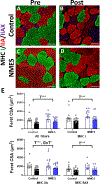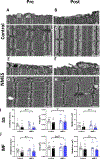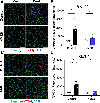Sustaining neuromuscular activation after total knee arthroplasty preserves skeletal muscle fiber size, contractility, and innervation in older adults
- PMID: 40653208
- PMCID: PMC12445151
- DOI: 10.1016/j.exger.2025.112831
Sustaining neuromuscular activation after total knee arthroplasty preserves skeletal muscle fiber size, contractility, and innervation in older adults
Abstract
Knee osteoarthritis (OA) is the leading cause of physical disability in older adults. Total knee arthroplasty (TKA) is a common treatment for advanced stage knee OA that alleviates knee pain, but it is associated with precipitous reductions in physical function early after surgery that can take months or years to recover. Sustaining neuromuscular activation after surgery with neuromuscular electrical stimulation (NMES) can improve recovery of physical function, but the mechanisms underlying its benefits are unclear. To examine the unique effects of NMES on skeletal muscle, we randomized older adult patients (70 % female) to early NMES (n = 11) or no intervention (n = 12) for 5 weeks after surgery. We measured skeletal muscle (vastus lateralis) fiber size, contractility, mitochondrial content, and mRNA abundance pre-surgery and 5 weeks post-surgery. NMES diminished TKA-induced muscle fiber atrophy in fast-twitch, myosin heavy chain (MHC) IIA fibers and improved or preserved single muscle fiber contractility in MHC I and MHC IIA fibers, respectively. In MHC IIA fibers, the beneficial effects of NMES to sustain fiber force production were explained at the molecular level by preservation of strongly bound, myosin-actin crossbridges. Additionally, TKA-induced increases in markers of denervation (CHRNA1 and MYOG) in controls were prevented by NMES. Our results identify beneficial effects of sustaining neuromuscular activation early, post-TKA with NMES on skeletal muscle fiber size and function and potential molecular mechanisms underlying these effects.
Keywords: Denervation; Disablement; Myosin; Rehabilitation.
Copyright © 2025 The Authors. Published by Elsevier Inc. All rights reserved.
Conflict of interest statement
Declaration of competing interest The authors declare no conflicts of interest.
Figures




References
-
- Anonymous, 2009. Prevalence and most common causes of disability among adults–United States, 2005. MMWR Morb. Mortal. Wkly. Rep. 58, 421–426. - PubMed
-
- Avramidis K, Strike PW, Taylor PN, Swain ID, 2003. Effectiveness of electric stimulation of the vastus medialis muscle in the rehabilitation of patients after total knee arthroplasty. Arch. Phys. Med. Rehabil. 84 (12), 1850–1853. - PubMed
-
- Bateman BT, Schmidt U, Berman MF, Bitnner EA, 2010. Temporal trends in the epidemiology of severe postoperative sepsis after elective surgery: a large, nationwide sample. Anesthesiology 112 (4), 917–925. - PubMed
Publication types
MeSH terms
Substances
Grants and funding
LinkOut - more resources
Full Text Sources
Medical
Research Materials

